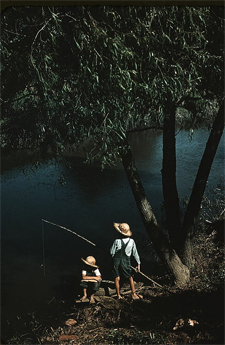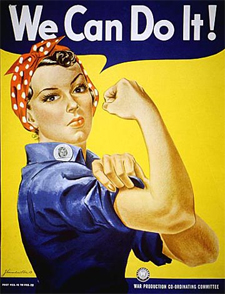

National Standards Content Standard 4 Understanding the visual arts in relation to history and cultures Achievement Standard Grades 1-4 * Students know that the visual arts have both a history and specific
relationships to various cultures Grades 5-8 * Students
know and compare the characteristics of artworks in various eras
and cultures Grades 9-12 * Students differentiate among a variety of historical
and cultural contexts in terms of characteristics and purposes of
works of art Source: ARTSEDGE
|
Advertisements flash on the television screen, each image no longer than 3 seconds. Students look at a photograph, illustration, or painting for about the same amount of time and nonchalantly comment, "It's just a picture." But wait, upon further inspection and some guided inquiry, the pictures soon come alive and tell a story. Some of the stories are historical, some personal, some made up. These stories behind the images bring rich context to the viewer who might be prompted to conduct further investigation. You never know what you may learn or the mysteries that may unfold until you dig deeper. Let's examine people as they are depicted in paintings, posters, and photographs and discover their stories. Paintings Early American Paintings in the Worcester Museum Don't miss this splendid display of portrait art that encompasses all of the paintings in the museum's collection that were created prior to 1830 by artists who were either born or active in America, including works painted abroad by those artists. Many of the artists are not well known, but the variety and quality are superb. The portraits are full of interesting details for the careful observer. There are several entry points to the collection, including timeline, artist, genre, place of origin, and a search box. Explore exhibitions and collections online. Of special interest to teachers are the online resources complete with activities and supporting materials for in-depth study of artists such as van Gogh, Vermeer, Mary Cassatt, and Henri Matisse. There are many nooks and crannies to discover, including British Conversation Pieces and Portraits of the 1700s, Seventeenth-Century French Painting, and Italian Painting of the Sixteenth-Century. Visiting the National Portrait Gallery is like walking into an art gallery that appears endless. Both paintings and photography are represented in their vast collections. Highlights at this site include a clever exhibit of Mathew Brady's works; A Brush with History, which features paintings of heroes, writers, statesmen, inventors, educators, musicians, artists, and scientists of America's past; and A Durable Memento: Portraits by Augustus Washington, African American Daguerreotypist. Each collection contains a wealth of background information. Posters and Illustrations James Whitcomb Riley was a prolific Indiana poet. His folksy rhymes reflected the culture of the era. Many of his poems were illustrated. One of Riley's works, "Good-Bye Jim," was a popular Civil War poem illustrated by Howard Chandler Christy. This Web site includes the poem and a few of the illustrations. This would be a great tie-in to the study of the Civil War or language arts. Norman Rockwell was one of the most prolific and beloved illustrators of the 20th century. His depictions of small-town life adorned the front cover of The Saturday Evening Post for years. At this site you will find his famous four freedoms, illustrating the social order for which World War II was being fought. In addition, there are examples of illustrations and how to interpret them under Eye Openers. Teachers can download a free resource packet. Powers of Persuasion: Poster Art from World War II Greeting you as you enter the page is the famous Montgomery Flagg poster, "I Want You!," created for World War I and revived for World War II. The exhibit is divided into two parts: One depicts the patriotic sense of duty and the strength of the nation. The other shows the high stakes and human cost of war. Have your students compare and contrast the colors, symbols, shading, and other techniques that were used in these posters. Have them write about which poster affects them the most and why. You might also have them write from the perspective of a person living during that time period. Photography America's First Look at the Camera: Daguerreotype Portraits and Views, 1839-1864 Portrait daguerreotypes produced by the Mathew Brady studio make up the major portion of this collection of 725 daguerreotypes. The collection also includes early portraits by pioneering daguerreotypist Robert Cornelius, studio portraits by black photographers James P. Ball and Francis Grice, and copies of painted portraits. In addition, there is a timeline of the daguerreotype era, the process, and a glossary of terms. America from the Great Depression to World War II: Photographs from the FSA-OWI, 1935-1945 Because of the economic situation during this time period, a new government agency, the Farm Security Administration, was created to help farmers. Photographers were hired into the program as part of the New Deal Era. Their job was to inform the public about the poverty in this country and the increased need to help people. Walker Evans was the first photographer, followed by Dorthea Lange, who had been doing the same kind of work in California. There were 98 photographers over the course of the project. These photographs depicting the lives of ordinary people form an extensive pictorial record of American life between 1935 and 1945. The collection contains approximately 107,000 black-and-white photographic prints, 164,000 black-and-white film negatives, and 1,610 color transparencies. South Texas Border, Photographs from the Robert Runyon Collection, 1900-1920 Robert Runyon was a commercial studio photographer. His collection of over 8,000 photographs documents life around the lower Rio Grande Valley during the early 1900s. There are many portraits of children and families representing the diverse cultures from that region. He also photographed school groups, sports teams, and the numerous excursion groups that came to Brownsville in the early 1920s as potential participants in the Valley land boom. |
Lessons and Guides In this Library of Congress module teachers learn about using primary sources with their students, Topics covered include:
Teaching with Documents—Nation The National Archives provides a series of worksheets that |

